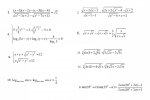gracias
1 + 3^(x/2) = 2^x
Already know the answer, just not the steps leading up to the answer. How do you get to the answer?
Tad more difficult question.
( √(2-√3) )^x + ( √(2+√3) )^x= 2^x
How do you factor that and find the answer? Seriously?
For me, a fruitful question, the ensuing dialog illuminated:
1) The difference between an expression and an equation.
(How long did it take me to began to realize that there is a hierarchy in algebra of beginning with the definition of fundamental operators (+,-,*,"/", exponentiation) followed by the construction of expressions as an amalgam of fundamental operators, followed by the use of the equal sign in one of two ways, a) equating two expressions, b) assigning a name to an expression to define a function.)
2) The realization that factoring is a procedure applied to expressions not equations which emphasizes the importance of distinguishing between the two.
(Regarding factoring: I only recently realized the Fundamental law of Algebra is a sort of analog of the fundamental law of Arithmetic. That is, that just as integers can always be reduced to a product of prime numbers, so to polynomials can always be reduced to a product of linear factors if you factor of the field of complex numbers.)
BTW. I am not a mathematician so if my insights are limited or erroneous I am happy for correction, nor am I going to embarrassed by the fact that such insights are merely pedagogic.
3) That not all equations can analytically be solved, i.e. transposed to a functional form.
An insight here is that an equation is, in a sense fundamentally a yes/no proposition. That is, an equation defines a subset of the Cartesian product of its variable set, so, in an impractical sort of way you could find this solution subset by feeding in each element of the said Cartesian product for a yes/not, accept/reject response.
Impracticable naturally, “Simple pimple” of course, but for me, large scale concepts like that allow me not freak out when confronted by something new … to at least know what ball park I am operating in.
Your question allowed me to learn something new and to confirm something old, so … thanks.


